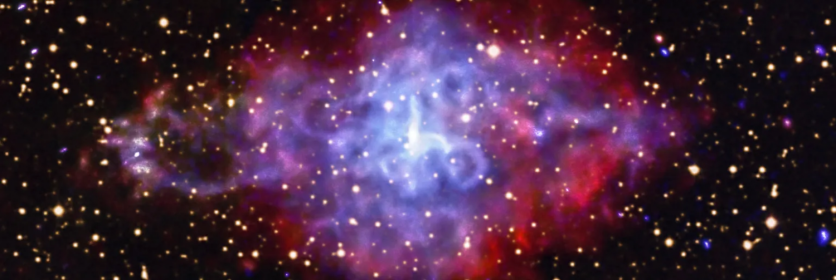NASA's Chandra X-ray Observatory has thoroughly explored the 3C 58 supernova remnant, focusing mainly on its neutron star, PSR J0205+6449. This neutron star, among others studied, provides insights into the densest objects known.
The research, conducted in collaboration with ESA's XMM-Newton, utilizes advanced imaging techniques to scrutinize the inner workings of neutron stars.

NASA's Chandra X-Ray Sees Dense, Weird Stars
The combined Chandra X-ray data, showcasing low-energy X-rays in red, medium-energy in green, and high-energy in blue, has been complemented by an optical image from the Digitized Sky Survey depicting stars within the field.
These observations highlight a rapidly spinning neutron star encircled by a torus of X-ray emissions and an extensive jet spanning light-years.
Astronomers in this study have analyzed extensive data sets from neutron stars to identify their equation of state, which is a fundamental description encompassing pressures and temperatures across various interior regions.
The presence of neutron stars within supernova remnants, including those in 3C 58, provides a unique opportunity for age estimation. The researchers utilized machine learning, a branch of artificial intelligence, to analyze the data against different equations of state.
Their findings indicate that many of these equations can be disregarded, particularly those lacking rapid cooling capability at higher masses.
In their study, astronomers leveraged specific neutron stars within supernova remnants, such as 3C 58. By estimating the ages of these remnants, they could determine the ages of the neutron stars formed during the explosions.
Notably, they observed that the neutron star in 3C 58 and two others exhibited markedly lower temperatures than the remainder of the neutron stars studied.
Read Also : NASA'S Hubble and Chandra Xray Revives a Dead Star Back to its Original Form Before its Violent Explosion
Accelerated Cooling
The team suggests that the enhanced mass of these neutron stars may contribute to their accelerated cooling relative to others. The presence of a greater number of particles in more massive neutron stars could trigger specific processes that hasten their cooling rate.
One plausible explanation for the rapid cooling is the occurrence of radioactive decay near the centers of these neutron stars. In this scenario, neutrinos, low-mass particles capable of easily traversing matter, could carry away a significant amount of energy and heat, leading to rapid cooling.
Alternatively, it is posited that exotic forms of matter within the cores of these neutron stars, which cool more rapidly, may also play a role in this phenomenon, according to NASA.
Related Article : NASA's Hubble Space Telescope Captures 'Butterfly Nebula' In Stunning Motion | Fun Facts About This Beautiful Space Butterfly

ⓒ 2025 TECHTIMES.com All rights reserved. Do not reproduce without permission.




